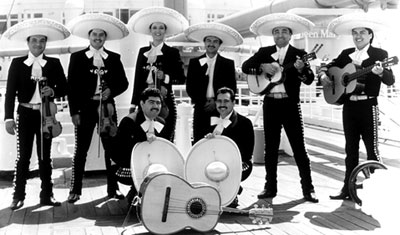- 998-252-0977 Desde Mexico
- 1-800-588-8681 USA and Canada
- 602-688-7378 International

Mariachi is a type of Mexican folk music originally played in a style called Son Jaliscience. Originally, Mariachi was played with only musicians and string instruments. The musicians would dress in white pants and shirts that the peasant farmers of the 18th century traditionally wore. During the 19th and 20th centuries, Mariachi began to reach cities such as Mexico City and Guadalajara. The style of Mariachi was gradually relabeled as Son, and modifications of the music began to take place. Trumpets were added to Mariachi bands and the musicians began wearing charro outfits. By the first half of the 20th century, Mariachi began to take on national prominence as it was promoted on the radio and at presidential inaugurations.
Indigenous Mexicans played music with drums, rattles, horns made from conch shells, and flutes. The Mariachi style of music did not appear until the the Spanish arrived in Mexico and introduced guitars, violins, brass instruments, harps, and woodwind instruments. Many of these quickly replaced simpler native instruments. Indigenous people quickly learned to not only play but also make these instruments, often modifying the tunings and shapes. The introduction of new types of instruments in Mexico, as well as the concept of musical groups gave rise to several folk musical styles, one of them being Mariachi.
At first, Mariachi music featured only string instruments and Mariachi players looked much different than those that perform today. Over time, as music began to evolve, the style of Mariachi changed from Son Jaliscense to Son. More modern Mariachi music is believed to have originated in Jalisco, specifically the town of Cocula. Today, Mariachi bands can be found all around the country from Jalisco to Playa del Carmen and beyond.
As Mariachi music became more well known, groups began playing in haciendas but after the Mexican Revolution, many workers were let go. In order to make money the Mariachi groups would have to wander around town, playing for a fee. They were also forced to play in public venues. The first recognized Mariachi recordings were made in 1908 and 1909.
 Mariachi music as it is known today developed in the 20th century as music began to transform. The Mexican government had a big hand in cultural promotion as a way to unify Mexican identity after the Revolution. One effort was to promote Mariachi as an international symbol of Mexican identity. The first nationwide radio broadcasting network was built in Mexico in the 1920s. During this time, Mariachi music was broadcast nationwide. Also around this time, Cuban music and jazz began to influence Mariachi and trumpets began being used as harps and violins were pushed into second place.
Mariachi music as it is known today developed in the 20th century as music began to transform. The Mexican government had a big hand in cultural promotion as a way to unify Mexican identity after the Revolution. One effort was to promote Mariachi as an international symbol of Mexican identity. The first nationwide radio broadcasting network was built in Mexico in the 1920s. During this time, Mariachi music was broadcast nationwide. Also around this time, Cuban music and jazz began to influence Mariachi and trumpets began being used as harps and violins were pushed into second place.
In Jalisco, where modern Mariachi originated, the charro tradition was strong and in the 1920s, they began being used as a cultural ideal in the film industry. The first charro movies debuted in the 1920s but the first person to sing Mariachi in a film was Tito Guizar in 1936. Mariachi music often had a negative perception in films with charros being portrayed as womanizers and heavy drinkers. This perception however did begin to change in the later part of the 20th century. At this time, Mariachi music started to become more professional and formal training became more widely available. Mariachi Vargas was one of the first major successes with the group appearing in many different films. Women began participating in Mariachi as well with some of the first female performers being Lucha Villa and Lola Beltran.
Mariachi groups can vary in size and not all use the same instruments when performing. It is often necessary for groups to know hundreds of songs as they are expected to play requests. Some well known Mariachi singers of the past include Pedro Infante, Luis Miguel, Silvestre Vargas, and many more.
Additional Mariachi Information: